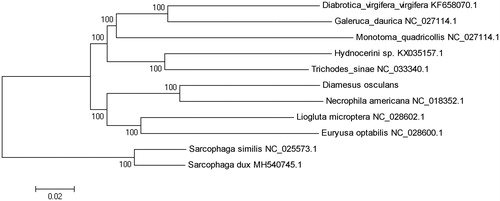Abstract
Diamesus osculans (Vigors, 1825) is a large size carrion beetle found on decaying corpse. Considering its potentially forensic value, the complete mitogenome of D. osculans was reported in present study. The mitogenome was assembled to 19398 base pairs in length. The composition of mitogenome is 39.45% for A, 9.64% for G, 35.43% for T and 15.48% for C. A total of 22 tRNA, 2 rRNA and 13 protein-coding genes (PCGs) were annotated. 21 tRNAs sequences could folded into the typical structure of clover-leaf, not including tRNA-Ser (AGN). A phylogenetic tree was finally constructed based on D. osculans and other species of Coleoptera.
Insects of Silphidae (Coleoptera), also called carrion beetles, were commonly spotted on animal or human corpse (Amendt et al. Citation2010). The species of subfamily Silphinae are more prefer to colonize on larger animal carcass (Anderson and Anderson Citation1982, Eggert Citation1992). Diamesus osculans (Silphinae) belongs to the species with the largest body-size in this subfamily. It can be attracted by light trap and animal remains (Williams Citation1981, Peck Citation2001). The silphine larvae normally feed on carrion remains and may compete with some other necrophagous insects like flies of Diptera and carrion beetle species (Anderson and Anderson Citation1982, Hoback et al. Citation2004). And in contrast with Diptera, the carrion beetle has a relatively longer lifecycle and could be found on the corpse at later decomposing stage when most maggots have dispersed from the corpse (Kocarek Citation2003, Matuszewski et al. Citation2008). So research on the development data and succession pattern of these beetles could provide time clues for the estimation on the postmortem interval (PMI), which represent the major challenge in forensic investigation. Considering the potentially forensic value of D. osculans, here we present the complete mitochondrial genome sequence of D. osculans. Phylogenetic analysis was also performed using several insects complete mitogenome of Coleoptera. Every voucher specimen was assigned with a unique code (CSU-MITO017-018) and deposited in the forensic insect herbarium of Department of Forensic Science, Central South University (Changsha).
The adults D. osculans samples were collected from bait trap in a tea garden in July 2019 from Chaozhou, China (N23°58′; E116°38′). The samples were deposited into pure ethyl alcohol and stored under −20 °C before sequencing. The raw DNA materials were extracted from the sample of D. osculans. A total of 12 overlapped PCR primers were designed to amplify the complete mitochondrial genome of D. osculans. The procedures and methods of amplification were listed as following: the initial denaturation step was performed at 94 °C for 4 min, followed by 35 cycles reaction of 30 s at 94 °C, annealing step at 50 °C for 30 s, elongation for 1 min at 72 °C, and the final elongation step for 10 min at 72 °C. Then the product of amplification was collected for sequencing.
The mitogenome sequencing was performed on platform of ABI PRISM 3730 (Applied Biosystems, Foster, CA, USA) with automatic sequencing procedure. The sequencing reads were assembled into contigs and constructed into the complete mitochondrial genome structure according to the sequence overlapping, then annotated using Geneious (v7.1.4) software. The online version of Open Reading Frame Finder (ORF Finder) was also used to confirm the open reading frames feature structure of protein-coding genes.
The complete mitochondrial genome of D. osculans was assembled with 19,398 base pairs in length. A total of 22 tRNA genes, 2 rRNA, and 13 protein-coding genes (PCG) were identified. The mitogenome was submitted to GenBank with accession number MN900863. Phylogenetic tree was constructed based on complete mitogenome of D. osculans with 8 species of Coleoptera using Neighbor-joining methods (). Two species of Sarcophagidae (Diptera) were co-analyzed as outgroups. The present reported complete mitogenome of D. osculans will provide important data to Silphidae.
Disclosure statement
No potential conflict of interest was reported by the author(s).
Additional information
Funding
References
- Amendt J, Campobasso CP, Goff ML, Grassberger M (Eds.). 2010. Current concepts in forensic entomology. Dordrecht, Heidelberg, London, New York: Springer; p. 57–68.
- Anderson RS, Anderson GS. 1982. Resource partitioning in the carrion beetle (Coleoptera: Silphidae) fauna of southern Ontario: ecological and evolutionary considerations. Can J Zool. 60(6):1314–1325.
- Eggert AK. 1992. Alternative male mate-finding tactics in burying beetles. Behav Ecol. 3(3):243–254.
- Hoback WW, Bishop AA, Kroemer J, Scalzitti J, Shaffer J. 2004. Differences among antimicrobial properties of carrion beetle secretions reflect phylogeny and ecology. J Chem Ecol. 30(4):719–729.
- Kocarek P. 2003. Decomposition and Coleoptera succession on exposed carrion of small mammal in Opava, the Czech Republic. Eur J Soil Biol. 39:31–45.
- Matuszewski S, Bajerlein D, Konwerski S, Szpila K. 2008. An initial study of insect succession and carrion decomposition in various forest habitats of Central Europe. Forensic Sci Int. 180(2–3):61–69.
- Peck SB. 2001. Review of the carrion beetles of Australia and New Guinea (Coleoptera: Silphidae). Aust J Ent. 40:1326–6756.
- Williams G. 1981. Records of the carrion beetle Diamesus osculans Vigor (Silphidae: Coleoptera) from New South Wales. Aust Ent Mag. 8:47.

